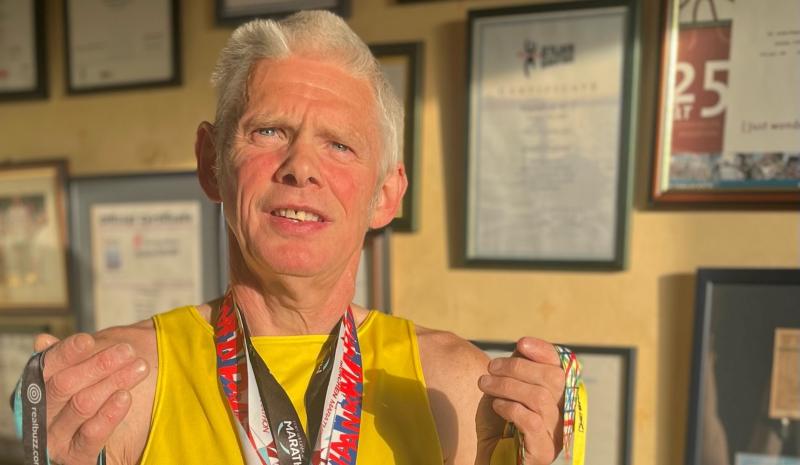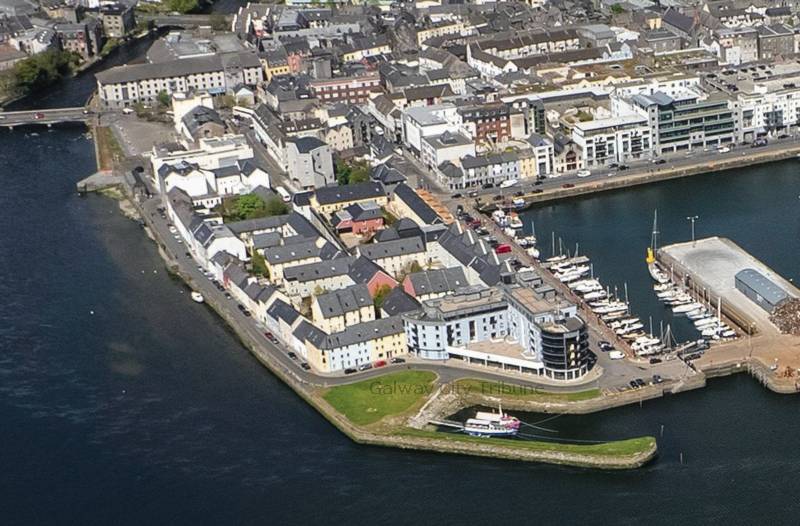News
Irish Water denies shower infection claims

Irish Water denies that the contaminated public water supply in Connemara is responsible for causing a near-fatal infection in one of its customers, a dialysis patient.
The public utility, which reaffirmed that it does not comment on individual cases, last week issued a statement suggesting Joe Wall from Carraroe was infected by something other than the public water supply connected to his shower.
Mr Wall, who featured in last week’s Connacht Tribune, however, has been told by health professionals that the most likely cause of him contracting peritonitis is the quality of water in An Cheathrú Rua, where a boil water notice is in place due to cryptosporidium.
Mr Wall, a 58-year-old peritoneal dialysis patient who receives treatment through his stomach by a Tenckhoff catheter, was admitted to hospital last Tuesday after complications from an E. Coli infection.
Mr Wall, as well as the consultants and nurses treating him, linked his infection to the contaminated water in An Cheathrú Rua’s public supply.
Similar problems were experienced by dialysis patients when the city’s water was contaminated with cryptosporidium some years ago, Mr Wall was told by hospital staff.
Speaking from his hospital bed on Tuesday, a week later, he said he had to have surgery to remove the tube from his abdomen, as it too may have been infected.
“Everything that could go wrong, did go wrong. The complications with dialysis mean that they kept me in (hospital) for the past week,” he said.
Mr Wall had hoped he could continue to get dialysis treatment at his home in Bothar Buí but this has been ruled out. “The nurse told me ‘not while the water situation in Carraroe is the way it is with cryptosporidium’. It means I’ll have to go to Galway for the haemodialysis,” said Mr Wall.
Mr Wall went public on his ordeal to warn other vulnerable people in areas of Galway where boil water notices are in place. Some 4,700 people in Carraroe are impacted by the boil water notice issued last month. Boil water notices remain in place in Williamstown, Leitir Mór and Loughrea.
Ervia, the parent company of Irish Water, in statement said: “While Irish Water cannot comment on specific cases we can confirm that in line with our commitments to our customers all vulnerable water users in the area were notified within an hour of Irish Water being notified that a boil water notice was being issued in South Connemara.”
Ervia added: “More importantly, we would also like to point out that there was never an issue with E. Coli in drinking water supplied in this area. All water supplied to customers in South Connemara has been chlorinated for the last 30 years – that is, zero E. Coli at our supply point.
“In addition, we have not turned the UV off at the water treatment plant which means that we are providing a dual barrier for E. Coli. If the E. Coli which caused the infection came from the water in this customer’s shower it did not originate in the public supply. Potential sources of this kind of contamination are re-contamination of the water supply within the owner’s property or other hygiene risks within the home.”
Meanwhile, the Environmental Protection Agency (EPA) has confirmed to Sinn Féin Senator Trevor O Clochartaigh that it has issued a summons to Irish Water alleging Irish Water has failed to implement an action programme agreed by the EPA last September, to improve the quality of water at An Cheathrú Rua.
The court case is listed for hearing in Dublin on May 23.
“As you will appreciate the EPA can make no further comment on this matter until such time as the court case has concluded,” the EPA told Senator Ó Clochartaigh.
Elsewhere, the boil water notice imposed on Ahascragh public water supply on April 1, 2016 has been lifted. Customers affected can now resume normal use of the water supply, it said.
Some 853 people were impacted by the notice which included group schemes in Lowville No.2, Castlegar West, Castlegar Lissyegan, Cornamucklagh, and Ballyglass. The precaution was lifted after advice from the Health Service Executive (HSE).
Irish Water and Galway County Council in a statement issued by Ervia, said they “acknowledge the patience, cooperation and assistance of the general public during the period of the boil water notice and greatly regrets any inconvenience caused to householders, the farming and the business community.”
Connacht Tribune
West has lower cancer survival rates than rest

Significant state investment is required to address ‘shocking’ inequalities that leave cancer patients in the West at greater risk of succumbing to the disease.
A meeting of Regional Health Forum West heard that survival rates for breast, lung and colorectal cancers than the national average, and with the most deprived quintile of the population, the West’s residents faced poorer outcomes from a cancer diagnosis.
For breast cancer patients, the five-year survival rate was 80% in the West versus 85% nationally; for lung cancer patients it was 16.7% in the west against a 19.5% national survival rate; and in the West’s colorectal cancer patients, there was a 62.6% survival rate where the national average was 63.1%.
These startling statistics were provided in answer to a question from Ballinasloe-based Cllr Evelyn Parsons (Ind) who said it was yet another reminder that cancer treatment infrastructure in the West was in dire need of improvement.
“The situation is pretty stark. In the Western Regional Health Forum area, we have the highest incidence of deprivation and the highest health inequalities because of that – we have the highest incidences of cancer nationally because of that,” said Cllr Parsons, who is also a general practitioner.
In details provided by CEO of Saolta Health Care Group, which operates Galway’s hospitals, it was stated that a number of factors were impacting on patient outcomes.
Get the full story in this week’s Connacht Tribune, on sale in shops now, or you can download the digital edition from www.connachttribune.ie. You can also download our Connacht Tribune App from Apple’s App Store or get the Android Version from Google Play.
Connacht Tribune
Marathon Man plans to call a halt – but not before he hits 160 races

On the eve of completing his 150th marathon, an odyssey that has taken him across 53 countries, Loughrea’s Marathon Man has announced that he is planning to hang up his running shoes.
But not before Jarlath Fitzgerald completes another ten races, making it 160 marathons on the occasion of his 60th birthday.
“I want to draw the line in 2026. I turn 57 in October and when I reach 60 it’s the finishing line. The longer races are taking it out of me. I did 20 miles there two weeks ago and didn’t feel good. It’s getting harder,” he reveals.
“I’ve arthritis in both hips and there’s wear and tear in the knees.”
We speak as he is about to head out for a run before his shift in Supervalu Loughrea. Despite his physical complaints, he still clocks up 30 miles every second week and generally runs four days a week.
Jarlath receives injections to his left hip to keep the pain at bay while running on the road.
To give his joints a break, during the winter he runs cross country and often does a five-mile trek around Kylebrack Wood.
He is planning on running his 150th marathon in Cork on June 4, where a group of 20 made up of work colleagues, friends and running mates from Loughrea Athletics Club will join him.
Some are doing the 10k, others are doing the half marathon, but all will be there on the finishing line to cheer him on in the phenomenal achievement.
Get the full story in this week’s Connacht Tribune, on sale in shops now, or you can download the digital edition from www.connachttribune.ie. You can also download our Connacht Tribune App from Apple’s App Store or get the Android Version from Google Play.
CITY TRIBUNE
Galway ‘masterplan’ needed to tackle housing and transport crises

From the Galway City Tribune – An impassioned plea for a ‘masterplan’ that would guide Galway City into the future has been made in the Dáil. Galway West TD Catherine Connolly stated this week that there needed to be an all-inclusive approach with “vision and leadership” in order to build a sustainable city.
Deputy Connolly spoke at length at the crisis surrounding traffic and housing in Galway city and said that not all of the blame could be laid at the door of the local authority.
She said that her preference would be the provision of light rail as the main form of public transport, but that this would have to be driven by the government.
“I sat on the local council for 17 years and despaired at all of the solutions going down one road, metaphorically and literally. In 2005 we put Park & Ride into the development plan, but that has not been rolled out. A 2016 transport strategy was outdated at the time and still has not been updated.
“Due to the housing crisis in the city, a task force was set up in 2019. Not a single report or analysis has been published on the cause of the crisis,” added Deputy Connolly.
She then referred to a report from the Land Development Agency (LDA) that identified lands suitable for the provision of housing. But she said that two-thirds of these had significant problems and a large portion was in Merlin Park University Hospital which, she said, would never have housing built on it.
In response, Minister Simon Harris spoke of the continuing job investment in the city and also in higher education, which is his portfolio.
But turning his attention to traffic congestion, he accepted that there were “real issues” when it came to transport, mobility and accessibility around Galway.
“We share the view that we need a Park & Ride facility and I understand there are also Bus Connects plans.
“I also suggest that the City Council reflect on her comments. I am proud to be in a Government that is providing unparalleled levels of investment to local authorities and unparalleled opportunities for local authorities to draw down,” he said.
Then Minister Harris referred to the controversial Galway City Outer Ring Road which he said was “struck down by An Bord Pleanála”, despite a lot of energy having been put into that project.
However, Deputy Connolly picked up on this and pointed out that An Bord Pleanála did not say ‘No’ to the ring road.
“The High Court said ‘No’ to the ring road because An Bord Pleanála acknowledged it failed utterly to consider climate change and our climate change obligations.
“That tells us something about An Bord Pleanála and the management that submitted such a plan.”
In the end, Minister Harris agreed that there needed to be a masterplan for Galway City.
“I suggest it is for the local authority to come up with a vision and then work with the Government to try to fund and implement that.”












